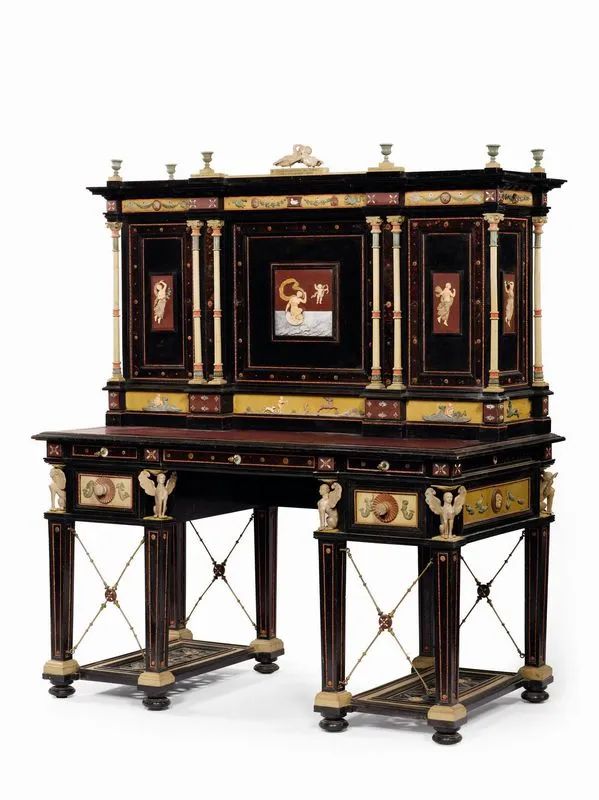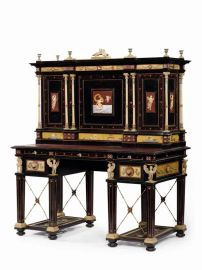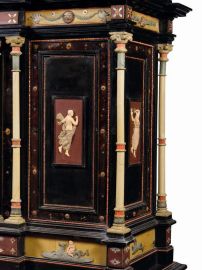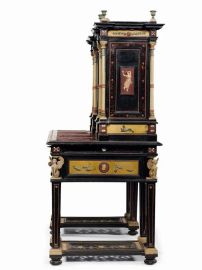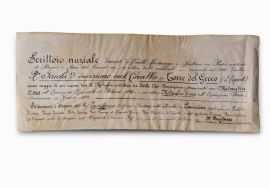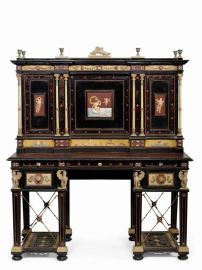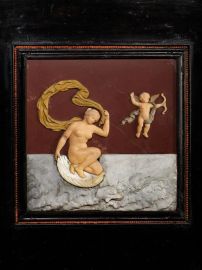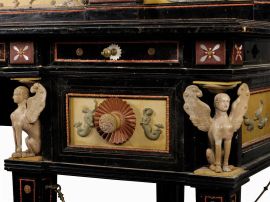Regia Scuola di incisione sul corallo
EBONY, LAVASTONE, GILT BRONZE, MOTHER-OF-PEARL, TORTOISESHELL AND CORAL CABINET
Torre del Greco, 1891, 164x142x74 cm
This piece of furniture stands on eight legs shaped as inverted obelisks divided in two groups, each with a platform and fret. In the front top there are drawers with reliefs with siren-like decorations, knobs in the shape of Medusa’s heads and on the sides there are sphinxes. Beneath the writing top, a thin band sports more drawers with tortoiseshell lining, enriched by coral and mother-of-pearl decorations on the borders. The upper body lies on a frame with reliefs depicting Erotes and it is divided in three parts by columns (double columns in the centre of the piece), in bright lavastone with green and red details. The doors have reliefs framed by coral, mother-of-pearls and tortoiseshell motifs: the relief in the centre depicts Venus on a shell with a dolphin among the waves and Eros firing an arrow; the others, on the other sides, depict dancing figures with the attributes of the Seasons. The upper cornice repeats the same colour tones and motifs of the inferior part of the cabinet, with masks and garlands, and topped by small vases and a small group of sculptures standing on a base with the inscription " SCUOLA DI INCISIONE SUL CORALLO TORRE DEL GRECO NAPOLI". Other inscriptions are evident on the lateral plinths.
A written sheet of paper is inside:
Wedding desk decorated with Corals, Tortoiseshell and Sculptures made of Antique Stones of Pompeii and Lavastones of the Mount Vesuvius etc.; the colors are all natural – created in 1891 by the R a Scuola d’Incisione sul Corallo of Torre del Greco (Naples) as prototype of a new Artistic furniture in Neo-Pompeian style; awarded with Golden medal at the National Exhibition of Palermo -1891- and with another Golden medal at the Italo-American Exhibition in Genoa -1892-.
Invention and design of Prof. Enrico Taverna from Turin, Director of the Scuola,= Execution by the students Palomba Vincenzo, Porzio Francesco, Betrò Vincenzo, Porzio Francesco, from Torre del Greco, and Ferrer Alessandro from Naples, and the stonecutter Ferrer Gaetano from Naples under the direction of the engraving professor Giuseppe A. Giansanti, from Trani.
The President Comm. Antonio Brancaccio from Torre del Greco
The origin of this work is accurately described in the long document, reported above, which attests how it was created by a famous professional school, established in Torre del Greco, a historical centre for the manufacture of coral. This cabinet is, therefore, the result of the efforts of some masters who worked under the supervision of the director Enrico Taverna (1864-1945 – fig. 1). He was responsible for the numerous innovations introduced in the school aimed at increasing its importance internationally.
The general catalogue of the National Exhibition of Palermo in 1891 reported the numerous pieces presented by the Royal School of Torre del Greco at that exposition. Besides the coral objects, there were also several albums of ornate designs, architectural and engineering drawings, some plaster, clay, wax models, sixty-eight engraved coral pieces, lavastone, mother-of-pearl, shell, ivory or wood, other artwork and, finally, a “cabinet with writing desk, in Pompeian style, made of ebony with engraved coral, lavastone, tortoiseshell and mother-of-pearl decorations”1. Some pictures of that period2 show our cabinet with other furnitures, two armchairs and a writing desk, manufactured with the same technique and the same style and exhibited at the National Exhibition of Turin in 1898.
The Regia Scuola di incisione sul corallo, di arti decorative e industriali (this was its full name) was founded in 1878 by a ministerial decree: the purpose was to train new workers in this technique that was the pride of the region, but it lacked workers and new projects. Situated in the former Convent of the Carmelites in Torre del Greco, after a few difficult initial years, it was completely renovated by Enrico Taverna from Turin, who directed it from 1886 to 1934.
Painter and versatile architect Taverna designed the mother-of-pearl, coral and metal chest, purchased by the King Humbert I during the International Exhibition in Milan in 1906, and a bronze and coral marble altar for the Church of St. Teresa in Torre del Greco3. Thanks to his contribution, the school of Torre del Greco would become a modern art school with laboratories specialized in different techniques. Although Taverna had to face much opposition and difficulties in his attempt to modernize the school, in 1888 he founded an art course on Pompeian Decorative Art. The discovery in Pompeii in 1890 of the Sarno Frigidarium would lead to the execution, by Taverna and some students, of a graphic reconstruction that gained a remarkable success during the Exhibition of Architecture in Turin. The course was carried on until 1898, and its most famous result is the cabinet, we are presenting here, which combines several of the techniques developed in the school.
Some of the artists who took part in the execution of this object and whose names are reported in the above-mentioned inscription, were well-known. The wood carvers Antonio Giansanti and Gaetano Ferrer were mentioned amongst the workforce since 1879. Giansanti (1827-1900) reproduced a relief in lavastone depicting The Night by Berthel Thorvaldsen4 and collaborated to the production of a black marble panel with lavastone and coral inlaid reliefs and cameos (1884). Gaetano Ferrer, most probably of Spanish origin, was most likely related to his namesake, who was one of the professors of carving in the Real Laboratorio delle Pietre dure of Naples from 1770 at least until 18055. Vincenzo Palomba is the author of a Bacchus, stored in the Coral Museum in Torre del Greco6. The surname Porzio, finally, is common to many artists of the place, the best known of which is Domenico, who worked assiduously between the nineteenth and twentieth centuries.
The architectural and decorative taste of the nineteenth century was inspired by the interior decorations and furnishings of the Roman period, but it is not until 1840 and 1850 that this style really developed.
Built around 1830 in the form of a Pompeian villa, the Römischen Bäder in Potsdam was designed by Ludwig Persius and by the most important German architect of that period, Karl Friedrich Schinkel, for the future Frederick Charles IV of Prussia, crown prince at the time and creator of the architectural project of the building. The particular interest in classical antiquities started in the eighteenth century and reached its highest level in that period. In Rome in 1840 J.-A.-D. Ingres finished his painting Antiochus and Stratonice (Chatilly, Musée Condé), in which the internal decorations and the furnishings were inspired by the drawings of the architect Victor Baltard. Ingres also collaborated with the architect J.-I. Hittorff for the Temple of Empedocles, a building commissioned by the Prince Jerome Napoleon Bonaparte for the actress Rachel in 18557. Designed by the architect Alfred-Nicolas Normand together with the decorator Charles Rossigneux8, the Maison pompéienne, dwelling of the Prince, was inaugurated a few years later in 1860. For the construction and decoration of the house in 1850, Norman took inspiration from some pictures of Pompeii, Rome and of other archaeological sites. Today, however, only a few drawings and some rare pictures still remain of the building.
Although there are copious examples we will only mention the most recent ones such as the Achilleion in Corfù, built in 1891 for the Empress Elisabeth of Austria by the Neapolitan Raffaele Carito and Antonio Landi or Villa Kerylos in Beaulieu-sur-Mer, built for Theodor Reinach at the beginning of the twentieth century based on the design of Emmanuel Pontremoli. In the latter building there are numerous furnishings influenced by the Pompeian style, as in the case of our cabinet, even if more scenographic in style and rarely mentioned in sources. In the case of this cabinet, the allusive figures of the seasons are almost flawlessly reproduced from a series of paintings discovered in Herculaneum in the eighteenth century that have since inspired decorations of furniture and porcelains as it had happened for the paintings and furnishings in Villa Favorita a Resina. The figures of the seasons were used also on some armchairs and a sofa, dating back from the end of 1700 and the beginning of 18009 that can be found today in Capodimonte.
This cabinet can be considered one of the latest example of the Neoclassical style of the beginning of the XVIII century: being more similar to Neoclassicism than to the opulent style of the late nineteenth century, its style better suits to today's taste. This artwork, perfectly executed, is, therefore, regarded as an object of study because designed by a group of artists and performed by skillful craftsmen. The Neapolitan art of that period reached its highest level thanks to this influence, as testified by the magnificent statues in Neo-alessandrine style by Vincenzo Gemito.
September 2016
Alvar González-Palacios
_____________________________________
1 Esposizione Nazionale Palermo 1891-189 Catalogo generale, repr. Palermo 1991, pp. 410-411.
2 C. Ciavolino, La Scuola del Corallo a Torre del Greco, Napoli 1988, p. 109.
3 Ibidem, p. 90.
4 Ibidem, pp. 66, 67, 77.
5 A. Gonzalez-Palacios, “Il Laboratorio delle Pietre Dure dal 1737 al 1805” in Le Arti Figurative a Napoli nel Settecento. Documenti e ricerche, edited by N. Spinosa, Napoli 1979, pp. 103, 106, 108, 112, 114, 115, 143, 151.
6 A. Putaturo Murano, A. Perriccioli Saggese, L’arte del corallo. Le manifatture di Napoli e di Torre del Greco fra Otto e Novecento, Naples 1989, fig. 37, p. 86.
7 R. Rosenblum, Transformations in late Eighteenth Century Art, Princeton 1967, pp. 134 sqq.
8 M.-C. Dejean de la Batie, “La Maison pompéienne du Prince Napoléon Avenue Montaigne” in Gazette des beaux-arts, 87, 1976, pp.127-134
9 A. Gonzalez-Palacios, il Tempio del Gusto, Milan 1984, p. 370, figg. 603, 605, 607
Comparative literature
Esposizione Nazionale Palermo 1891-1892. Catalogo generale, repr. Palermo 1991, pp. 410-411;
C. Ciavolino, La Scuola del Corallo a Torre del Greco, Napoli 1988

